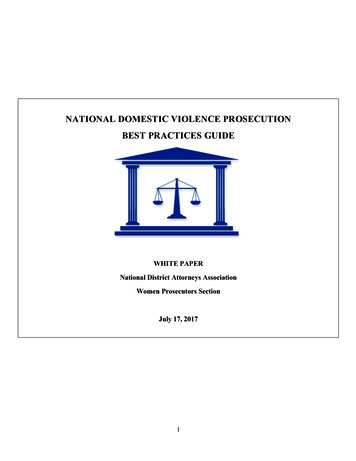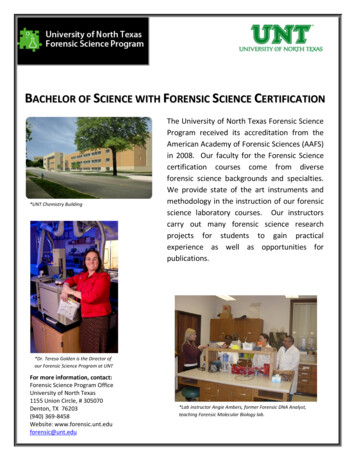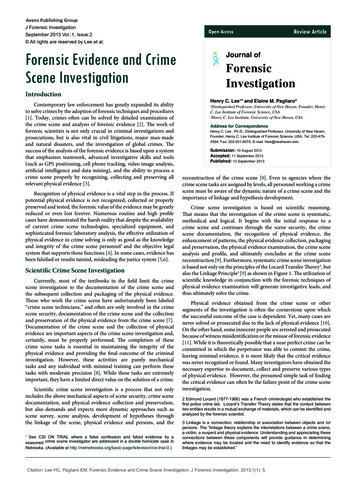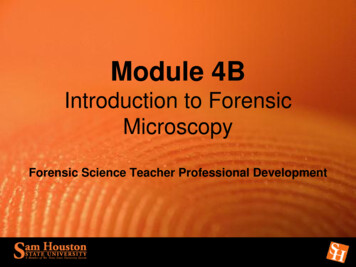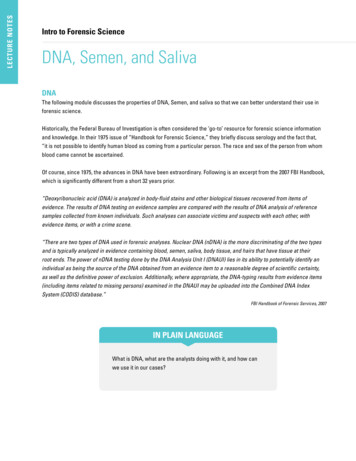
Transcription
Philippine Journal of Science147 (1): 1-8, March 2018ISSN 0031 - 7683Date Received: 09 Sep 2016Forensic Science in the Prosecution of Illegal Drugs CasesMaria Socorro I. DioknoFree Legal Assistance Group, 2F, Eastside Building, 77 Malakas Street,Brgy. Pinyahan, Diliman, Quezon City, Metro Manila, PhilippinesIn light of the current “war on drugs,” forensic science plays a significant role in the prosecutionof cases involving illegal drugs to ensure that no innocent persons are ever wrongfully convicted.Prohibited drugs have been a problem in the country since the 1800s. The Philippines hasbeen recognized as “a significant source of high potency crystalline methamphetamine (shabu)used both domestically and exported to locations in East and Southeast Asia and Oceania.”Yet, the prosecution of those involved with dangerous drugs has not been largely successful.Forensic chemists are crucial to successful drug prosecution but current forensic capabilitiescould be enhanced. Also, the vital role forensic laboratories play in the area of drug control isunder-recognized. Forensic laboratories could – and should – provide scientific guidance andadvice to strengthen law enforcement, activate early warning systems, enhance regulatory andmonitoring capabilities, and develop responsive and effective drug control, prevention, andtreatment policies.Key words: chain of custody, current forensic capabilities, dangerous drugs, drug control, forensicchemist, prosecutionINTRODUCTIONNo innocent person should ever be condemned to death orimprisoned for any length of time. Yet, in the Philippines,innocents have been wrongfully convicted, and in at leasttwo cases, doubts have been raised on the guilt of twoconvicts executed by lethal injection.In People v. Mateo (2004), the Supreme Court reviewedstatistics on capital cases. It found that between 1993and Jun 2004, “the trial courts have imposed capitalpunishment in approximately 1,493, out of which 907cases have been passed upon in review by the Court. Inthe Supreme Court, where these staggering numbersfind their way on automatic review, the penalty has beenaffirmed in only 230 cases comprising but 25.36% of thetotal number. Significantly, in more than half or 64.61%of the cases, the judgment has been modified through an*Corresponding author: flag@flag.com.phorder of remand for further proceedings, by the applicationof the Indeterminate Sentence Law, or by a reduction of thesentence. Indeed, the reduction by the Court of the deathpenalty to reclusion perpetua has been made in no lessthan 483 cases or 53.25% of the total number. The Courthas also rendered a judgment of acquittal in sixty-five (65)cases. In sum, the cases where the judgment of death haseither been modified or vacated consist of an astounding71.77% of the total of death penalty cases directly elevatedbefore the Court on automatic review .”What these statistics point to is the fallibility of thePhilippine criminal justice system and the importance offorensic science in ensuring that no one is ever wrongfullyconvicted.For space limitations, and in light of the current “war ondrugs,” this article will focus on the role of forensic sciencein the prosecution of cases involving illegal drugs. Thepaper provides an analytical summary of the juxtaposition1
Philippine Journal of ScienceVol. 147 No. 1, March 2018of law and forensic science in dangerous drugs cases,presents a critical perspective of the state of forensicscience in the prosecution of cases involving dangerousdrugs, and attempts to draw broader conclusions; thepaper, however, is limited by its lack of field interviews.Illegal Drugs in the PhilippinesIn its 2015 Annual Report, the Philippine Drug EnforcementAgency (PDEA) characterized the Philippines as a“producing and consuming country of illegal drugs.”Prohibited drugs have been a problem in the country sincethe 1800s. In 1902, there were about 40,000 Filipinoand Chinese opium users Victoria (2016). Seventy yearslater, in 1972, there were about 20,000 drug users, withmarijuana as their top drug of choice (DDB 2016). In 2012,the Dangerous Drugs Board in collaboration with thePhilippine Normal University conducted a “NationwideSurvey on the Current Nature and Extent of Drug Abusein the Philippines.” A key statement was “based on thesurvey, it was estimated that there could be 1.3 milliondrug users” in the country. Shabu (methamphetamine HCl)and marijuana (cannabis) are the dominant illicit drugs ofchoice, followed by other drugs such as cocaine (cocao),ecstasy [methylenedioxymethamphetamine (MDMA)]and others (PDEA 2015).PDEA data show that in 2016, about a third (27%) of allbarangays are “drug affected” (PNP 2016). The DangerousDrugs Board recently clarified the definition of a “drugaffected barangay.” In Board Regulation No. 2 series of2016, the Board defined a “drug-affected barangay” asa barangay which “has reported presence of drug user,pusher, manufacturer, marijuana cultivator, or other drugpersonality, drug den, marijuana plantation, clandestinedrug laboratory, and facilities related to production ofillegal drugs.” The Board also designated three categoriesof drug affectation: (a) seriously affected [those barangaysthat have “reported at least 1 clandestine drug laboratoryor marijuana plantation in the community, reportedpresence of more than 20% of the barangay’s totalpopulation are drug personalities (i.e., users, pushers,financier), and reported presence of three or moredrug dens or tiangges]; (b) moderately affected (thosebarangays that have “reported presence of 2-20% of thebarangay’s total population are drug personalities”); and(c) slightly affected (those barangays that have “reportedthe presence of less than 2% of total barangay populationare drug personalities”). Because Board Regulation No.2 was adopted only on 3 Aug 2016, it is not possible todisaggregate PDEA’s current statistics on drug-affectedbarangays into the three categories of drug affectation.The 2009 World Drug Report of the United Nations Officeon Drugs and Crime (UNODC) identified the Philippines2Diokno: Forensic Science in Prosecution of Drugsas “a significant source of high potency crystallinemethamphetamine (shabu) used both domestically andexported to locations in East and Southeast Asia andOceania. Manufacture often occurs in industrial-sizedlaboratories operated by transnational organized crimewith most chemists being foreign nationals. In 2007, anotable increase in the seizure of methamphetaminerelated manufacturing facilities was reported with ninesignificant laboratories (and an additional 13 chemicalwarehouses) seized, increasing in 2008 to 10 laboratoriesmarking the third consecutive year of increases.”In the same year, the US State Department issued a report,which identified corruption and poor law enforcement asamong the factors that exacerbated the problem of illegaldrug use in the country.Lapses in the Prosecution of Those Involved in IllicitDrugsThe prosecution of those involved with dangerous drugshas not been largely successful. In People v. Ancheta etal. (2012), the Supreme Court reiterated its observationsin People v. Garcia (2009), which noted the high rate ofacquittals and dismissals in cases involving dangerousdrugs:“We close with the thought that this Court is notunaware that in the five years that R.A. No. 9165has been in place, the rate of cases that resultedin acquittals and dismissals was higher than therate of conviction. Under PDEA records, thedismissals and acquittals accounted for 56%because of the failure of the police authorities toobserve proper procedure under the law, amongothers. A recent international study conducted in2008 showed that out of 13,667 drug cases filedfrom 2003 to 2007, only 4,790 led to convictions(most of which were cases of simple possession);the charges against the rest were dismissed orthe accused were acquitted.”The Court then went further, looking into its own records,where it noted: “Our own data on the cases filed withus from 2006 to 2011 show that, out of those in whichthis Court made acquittals and reversals, 85% involvedfailure of the prosecution to establish the arresting officerscompliance with the procedural requirements outlined inSection 21 of R.A. 9165” (People v. Ancheta 2012).Most cases involve what is known as “buy-bustoperations,” which the Supreme Court has described asfollows:“A buy-bust operation gave rise to the presentcase. While this kind of operation has beenproven to be an effective way to flush out illegal
Philippine Journal of ScienceVol. 147 No. 1, March 2018transactions that are otherwise conductedcovertly and in secrecy, a buy-bust operationhas a significant downside that has not escapedthe attention of the framers of the law. It issusceptible to police abuse, the most notoriousof which is its use as a tool for extortion. InPeople v. Tan, this Court itself recognized thatby the very nature of anti-narcotics operations,the need for entrapment procedures, the use ofshady characters as informants, the ease withwhich sticks of marijuana or grams of heroin canbe planted in pockets of or hands of unsuspectingprovincial hicks, and the secrecy that inevitablyshrouds all drug deals, the possibility of abuseis great. Thus, courts have been exhorted tobe extra vigilant in trying drug cases lest aninnocent person is made to suffer the unusuallysevere penalties for drug offenses. Accordingly,specific procedures relating to the seizure andcustody of drugs have been laid down in the law(R.A. No. 9165) for the police to strictly follow.The prosecution must adduce evidence thatthese procedures have been followed in provingthe elements of the defined offense (Emphasissupplied and citations omitted.)” People v.Umipang (2012).Crucial to a drug prosecution is the establishment of whatis known in law as corpus delicti (body of the crime).Corpus delicti is any objective proof that a crime hasindeed taken place and this must be proven in order toconvict a person of the crime (Rimorin v. People 2003;Black’s Law Dictionary). In cases involving dangerousdrugs, the corpus delicti is the presentation of thedangerous drug itself (People v. Climaco 2012). In Peoplev. Climaco (2012), the Supreme Court reiterated its rulingin People v. Alcuizar, stressing the State’s obligation toprove the corpus delicti in cases involving dangerousdrugs:“The dangerous drug itself, the shabu in thiscase, constitutes the very corpus delicti of theoffense and in sustaining a conviction underRepublic Act No. 9165, the identity and integrityof the corpus delicti must definitely be shownto have been preserved. This requirementnecessarily arises from the illegal drugsunique characteristic that renders it indistinct,not readily identifiable, and easily open totampering, alteration or substitution either byaccident or otherwise. Thus, to remove any doubtor uncertainty on the identity and integrity ofthe seized drug, evidence must definitely showthat the illegal drug presented in court is thesame illegal drug actually recovered from theDiokno: Forensic Science in Prosecution of Drugsaccused-appellant; otherwise, the prosecutionfor possession under Republic Act No. 9165fails.”The chain of custody in drugs cases has been describedby the Supreme Court as referring to four links: “first,the seizure and marking, if practicable, of the illegal drugrecovered from the accused by the apprehending officer;second, the turnover of the illegal drug seized by theapprehending officer to the investigating officer; third,the turnover by the investigating officer of the illegal drugto the forensic chemist for laboratory examination; andfourth, the turnover and submission of the marked illegaldrug seized by the forensic chemist to the court.” (Peoplev. Dahil and Castro 2015).Forensic chemists play crucial roles in the third and fourthlinks of the chain of custody in illicit drugs cases.Role of Forensic Chemists in the Prosecution ofthose Involved in Illicit DrugsUnder Philippine law, all seized or confiscated orsurrendered dangerous drugs, plant sources, controlledprecursors, and essential chemicals must be turned overto the PDEA Laboratory Service for qualitative andquantitative analysis within 24 hours from confiscation,seizure, or surrender (Section 21, Republic Act 9165). ThePDEA Laboratory Service must issue a certification of itsexamination results, under oath by the forensic laboratoryexaminer, within 24 hours from receipt of the subjectitems. However, when the volume of the dangerous drugs,plant sources, and/or controlled precursors does not allowthe testing to be completed within 24 hours, a partiallaboratory examination report may be provisionally issuedstating the quantities of drugs still to be examined; but afinal certification on the completed forensic laboratoryexamination must be issued within the next 24 hours.These requirements form the third and fourth links in thechain of custody of dangerous drugs.The third link in the chain of custody of dangerous drugsrefers to the turnover by the investigating officer of theillegal drugs to the forensic chemist, to make sure thatthe drugs seized, recovered, or surrendered are the samedrugs that will be subjected to quantitative and qualitativeanalysis by the forensic chemist. This means that oncethe investigating officer delivers the suspected illegaldrugs to the forensic chemist, the forensic chemist mustexamine the suspected substance, determine its chemicalcomposition (qualitative analysis), and find out whetherit contains any illegal drugs. The forensic chemist mustalso establish the amount of the dangerous drug present inthe substance as well as its purity (quantitative analysis).There have been a series of cases where doubts wereraised as to whether the dangerous drugs tested actually3
Philippine Journal of ScienceVol. 147 No. 1, March 2018came from the accused. In People v. Dahil and Castro(2015), the forensic chemist who examined the suspectedsubstances certified that she had “no personal knowledgeas from whom and where said substance was taken.”In People v. Beran, cited in People v. Dahil (2015), thepolice investigator claimed to have personally deliveredthe drugs to the laboratory for testing, “but there was noshowing who received the drug from him.”The fourth link refers to the turnover of the marked illicitdrugs by the forensic chemist to the Court, when presentedas evidence in the case. The Supreme Court, in People v.Pajarin and Pallaya (2011), recognized the important roleof forensic chemists in the prosecution of cases involvingprohibited drugs: “Further, as a rule, the police chemistwho examines a seized substance should ordinarily testifythat he received the seized article as marked, properlysealed and intact; that he resealed it after examination ofthe content; and that he placed his own marking on thesame to ensure that it could not be tampered pending trial.In case the parties stipulate to dispense with the attendanceof the police chemist, they should stipulate that the latterwould have testified that he took the precautionary stepsmentioned.”In several cases, forensic chemists failed to testify incourt. In other cases, forensic chemists failed to testifyhow the drugs were kept while in their custody until thedrugs were transferred to the court. In these cases, theaccused were acquitted.Current Forensic Capabilities in Illicit Drugs CasesForensic examination of illicit drugs seized or recoveredby, or surrendered to, authorities are undertaken by theCrime Laboratory of the Philippine National Police [PNP]and the PDEA Laboratory Service.The PNP Crime Laboratory includes a chemistry division,which conducts qualitative examinations of dangerousdrugs, substances, and paraphernalia and examines urineand other body fluids for the presence of dangerous drugs,essentially to determine the presence of dangerous drugs.By law, the PDEA Laboratory Service is empowered toexamine all seized, surrendered, or recovered dangerousdrugs. The PDEA Laboratory Service consists of threedivisions. The Examination Division conducts laboratoryexaminations on seized dangerous drugs, controlledprecursors and essential chemicals, drug tests on arrestedpersons, and assessment and processing of clandestinelaboratories; it also testifies in court as expert witnesses.The Documentation and Evidence Division manages theinventory and safekeeping of drug and non-drug evidenceand keeps and stores the evidence in the evidence room/storage area. It also facilitates the destruction of piecesof drug and non-drug evidences that are no longer4Diokno: Forensic Science in Prosecution of Drugsneeded in court and prepares certificates of destructionsigned by appropriate witnesses, as well as witnesses thedestruction of expired medicines and controlled precursorsand essential chemicals. The Special Research Divisionconducts research, develops or validates new methods ofanalysis of drugs and controlled precursors and essentialchemicals, conducts quantitative examinations ofdangerous drugs and controlled precursors and essentialchemicals, and establishes capability on impurity profilingof seized methamphetamines.In its 2014 Annual Report, PDEA reported: “at the endof 2014, all PDEA laboratories nationwide are alreadyoperational. All regional forensic laboratories areequipped with essential tools and equipment for illegaldrug detection and investigation and can analyze, detect,collect, and process samples and pieces of evidence.”Independent Assessment of Current ForensicCapabilities in Dangerous Drugs CasesThe UNODC’S Global Synthetics Monitoring: Analyses,Reporting and Trends (SMART) Programme (GlobalSmart Programme) assessed the forensic infrastructurein 11 countries in Asia, and sent missions to Cambodia,Indonesia, and the Philippines (Hammond). The rationalebehind the assessment was the recognition of the “crucialimportance of forensic laboratory as source of information[on] physical and chemical characteristics, purities,trends, patterns of manufacturing and trafficking, lawenforcement operations, regulatory authorities, criminaljustice system.” Among the findings were: The existence of multiple laboratories, (thePhilippines, for example, has 20 laboratories),which could lead to “drug abuse patterns andtrafficking trends [being] valid for the localsituation,” making it difficult to arrive at nationalpatterns and trends. “Multiple law enforcement agencies haveoverlapping anti-narcotic functions and ownsupporting drug lab,” which could lead to “interagency rivalry and jealousy” and thus “poorcooperation and challenge to pool data.” Limited interaction between the national drugcontrol body and the forensic laboratory, implyingthat the “importance of laboratory [is] often notunderstood.” “Most drug labs have not received training inthe forensic aspects of clandestine laboratoryinvestigations.” “Forensic investigators are not educated onpotential dangers posed by chemicals and chemical
Diokno: Forensic Science in Prosecution of DrugsPhilippine Journal of ScienceVol. 147 No. 1, March 2018reactions in clandestine labs.” The Philippine laboratories are “well-equipped.” No quantitative testing on drug samples isconducted in the Philippines “due to law imposedtime restrictions on identifying drugs samples.” In the Philippines, “quantitative tests are only madeto determine the actual content of pure drug tocalculate the reward for drug informants.”Vital Role of Forensic Laboratories in Drug ControlThese findings point not only to a need to enhancePhilippine forensic capabilities but, more importantly, tothe imperative to recognize, understand, and appreciatethe vital role forensic laboratories play in the area of drugcontrol. At present, it appears that the PDEA LaboratoryService contributes to drug control efforts in a limitedway, perhaps largely circumscribed by the strict timerequirements imposed by the law. Yet, it could– and should– provide scientific guidance and advice to strengthen lawenforcement, activate early warning systems, enhanceregulatory and monitoring capabilities, and developresponsive and effective drug control, prevention, andtreatment policies. As noted by Remberg and Stead (2005):“Despite their central role in drug control,forensic laboratories are usually seen and usedas tools and servants rather than as resourcesand partners. At best, the value of individuallaboratory results to answer a specific question,to save a life, to help in treatment or to identify orconfirm a crime is recognized. However, there ismuch less recognition of the fact that collectively,as a body of information, laboratory results alsoconstitute a valuable commodity in their ownright by helping to identify new potential threatsand health hazards, especially those related tonew drugs and manufacturing methods, newsources of drugs and drug availability, newpurities and cutting agents, and new productsand drug combinations.”xxx“In general, there is a need for wider recognitionof the added value of an integrated nationalscientific support service as an equal partnerwith law enforcement, judicial, regulatoryand health authorities. Laboratories need tobe provided with the resources they requireto sustain high-quality services, and they andtheir scientists need to be given the opportunityto participate actively in relevant regionaland global networks of forensic scientists toexchange experience and analytical findingsat an early stage. Most importantly, nationalinstitutions and government agencies need tobe made more aware of the range of work andpossibilities of scientific support to ensure betteruse of available laboratory resources and greaterrecognition of the potential value of scientificinformation, beyond the use of laboratory resultsas evidence in court.”UNODC (2010) underscores the valuable contributions offorensic science to the criminal justice system: “Forensicservices are key to an effective and fair criminal justicesystem because they provide objective and timelyinformation for multiple phases at different stages of thecriminal justice process. For example, forensic servicesare used by police to identify suspects in the investigativephase of the criminal justice process. Forensic services arealso used by attorneys and judges during the trial phase ofthe process. The ultimate objective of forensic science is tocontribute to finding the truth, more precisely to providethe criminal justice system with answers, using objectiveevidence, and by questions aimed at determining the guiltor innocence of an offender. It is therefore essential thatforensic services are provided by a highly qualified andimpartial entity.The investigation and prosecution of dangerous drugscases would benefit from advice and guidance by PDEAand PNP laboratories, especially in relation to thecollection, handling, and packaging of seized, recovered,or surrendered drug evidence.Specifically – with regard to packaging of seized,surrendered, or recovered dangerous drugs – the PNPDrug Evidence Bag - Chain of Custody portrayed in theRevised PNP Manual on Anti-Illegal Drugs Operationsand Investigation (2014) appears to be one of a kind.Yet, forensic scientists abroad have stressed the needfor different types of packaging of dangerous drugs,depending on the type of drug seized, recovered, orsurrendered. For example, seized or recovered plants andplant materials should not be placed inside plastic bagsbecause of moisture content and the tendency to growmold; syringes or sharp objects should be placed insidecardboard cartons or glass vials and labeled as a potentialbiohazards (National Forensic Science TechnologyCenter).Both laboratories could also consider applying foraccreditation with the Philippine Accreditation Board.Forensic experts worldwide have been encouragingcrime laboratories to secure accreditation, mainly inconsideration of the need to regulate crime laboratories aswell as to address major shortcomings in forensic scienceservices (Tilstone 2008; Giannelli 2006). Accreditation5
Philippine Journal of ScienceVol. 147 No. 1, March 2018is an essential external and independent review and areliable indication of the laboratories’ technical expertise;“it provides formal recognition that laboratories arecompetent, impartial and independent” (ILAC 2015).Accreditation ensures that all forensic services areprovided in accordance with accepted internationalstandards. The benefits from accreditation that willredound to both PNP and PDEA laboratories are explainedby the International Laboratory Accreditation Cooperation(ILAC), the global association for the accreditation oflaboratories:Accreditation benefits laboratories by allowingthem to determine whether they are performingtheir work competently to appropriate standards,and provides them with a benchmark formaintaining that competence. Many suchlaboratories operate in isolation to their peers.A regular assessment by an accreditation bodyprovides an opportunity for an independenttechnical evaluation of their performance andchecks all aspects of a facility’s operationsrelated to consistently producing accurateand dependable data. Areas for improvementare identified and discussed, and a detailedreport provided at the end of each visit. Wherenecessary, follow-up action is monitored by theaccreditation body so the facility is confident thatit has taken the appropriate corrective action(ILAC 2015).But accreditation alone may not be sufficient to ensurethe integrity of the PNP and PDEA laboratories and thequality of their testing. In 2009, the United States NationalAcademy of Sciences recommended that crime laboratoriesshould be independent of law enforcement, rationalizing:“The best science is conducted in a scientific setting asopposed to a law enforcement setting. Because forensicscientists often are driven in their work by a need to answera particular question related to the issues of a particularcase, they sometimes face pressure to sacrifice appropriatemethodology for the sake of expediency” (NationalAcademy of Sciences 2009). Perceived and real bias, fiscalautonomy of crime laboratories, and the fundamentallydifferent rules under which law enforcement operationsand science operate are the principal reasons why crimelaboratories should be independent of law enforcementagencies (Goldman 2009). An academic, however, warns:“In brief, direct control can provide stronger incentivesand improve coordination, but strong incentives to respondto the principal’s demands can increase both good andbad behavior and not all coordination is consonant withthe pursuit of justice. On net, police control could eitherimprove or degrade the performance of the crime lab”(Warren 2015).6Diokno: Forensic Science in Prosecution of DrugsBoth the PNP and PDEA laboratories are attached to lawenforcement agencies; to ensure that these laboratoriesmaintain their integrity and assure the qualities of theirservices, they may consider adopting the internationallyprescribed minimum standards for the analysis of seized,surrendered, or confiscated dangerous drugs. Theseinternational standards are proposed by the ScientificWorking Group for the Analysis of Seized Drugs(SWGDRUG), a group of 20 forensic experts from aroundthe globe who “work to improve the quality of the forensicexamination of seized drugs” (SWGDRUG 2016). Amongthe key minimum standards are: The adoption and implementation of a Code ofProfessional Practice for Drug Analysts, which“provide(s) the framework of ethical values andscientific and legal obligations within which theanalyst should operate.” The Code would requiredrug analysts to: “strive to demonstrate that theintegrity and security of evidential materials andthe information derived from their analysis havebeen maintained while in their possession; employan appropriate analytical approach, using thefacilities available; present advice and testimony,whether written or oral, in an objective manner; beprepared to reconsider and, if necessary, changetheir conclusions, advice or testimony in lightof new information or developments, and takethe initiative in informing their employer andcustomers promptly of any such changes that needto be made; and take appropriate action if there ispotential for, or there has been, a miscarriage ofjustice due to new circumstances that have come tolight, incompetent practice or malpractice.” The development of both a sampling strategy anda sampling scheme when conducting qualitativeanalysis of samples of seized, surrendered, orconfiscated drugs. A sampling strategy indicateswhether sampling is statistical (probability-based)or not; selected samples must be analyzed tomeet the SWGDRUG minimum standards fordrug identification “if statistical inferences areto be made about the chemical identity of thepopulation.” A sampling scheme is “an overallapproach which includes population determination,selection of the sampling plan and procedureand, when appropriate, sample reduction prior toanalysis.” The use of multiple uncorrelated techniques in theforensic identification of seized, confiscated, orsurrendered drugs; Strict adherence to the minimum standardsin the chemical analysis of items seized from
Philippine Journal of ScienceVol. 147 No. 1, March 2018clandestine drug laboratories, including, amongothers: the exercise of caution and routine safetyprotocols when conducting quantitative andqualitative tests on drugs seized from clandestinelaboratories, including the use of protectivebreathing equipment, specialized ventilationequipment (such as fume hoods), personalprotective equipment (e.g., safety glasses, chemicalresistant gloves, respirators, face masks, airmonitors, etc.), specialized emergency equipmentstations, chemical disposal and destructionfacilities and procedures, and specialized evidencereceipt, storage and disposal requirements designedto mitigate expected dangers (e.g., limited samplesize, proper packaging of reactive materials,use of absorbents, p
Black's Law Dictionary). In cases involving dangerous drugs, the corpus delicti is the presentation of the dangerous drug itself (People v. Climaco 2012). In People v. Climaco (2012), the Supreme Court reiterated its ruling in People v. Alcuizar, stressing the State's obligation to prove the corpus delicti in cases involving dangerous drugs:




